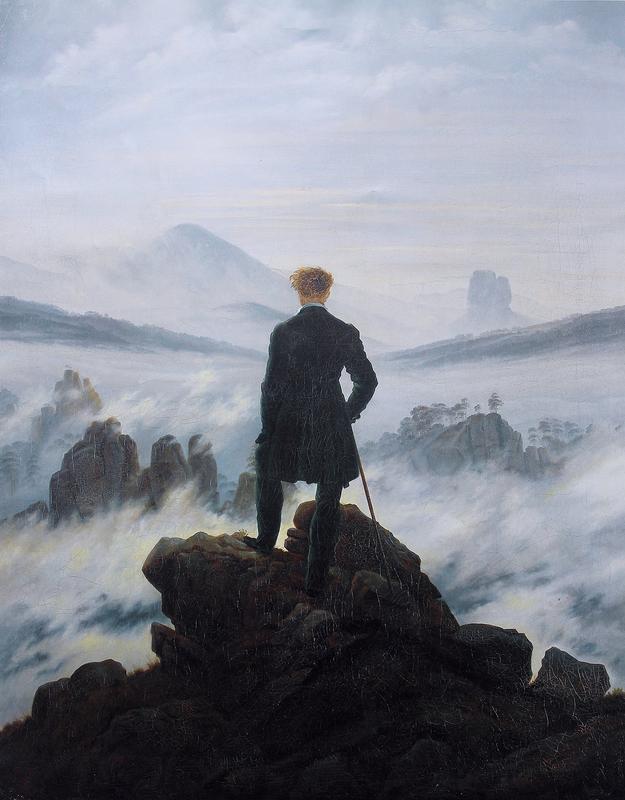More about Wanderer above the Sea of Fog
- All
- Info
- Shop

Sr. Contributor
Even if you’ve never laid eyes on Wanderer Above a Sea of Fog before, it likely feels familiar.
Perhaps because it is considered to be one of the Romantics period’s masterpieces or more likely it reminds you of that time around 2013 when all movie posters started to look the exact same.
It was a simple formula: a tiny silhouette of a man’s back amidst a gigantic apocalyptic wasteland. Star Trek into Darkness and Inception are just two examples of the posters inspired by this painting. While the composition was borrowed, the intent was ignored. Wanderer Above a Sea of Fog gives a sense of wonder, an awe of experiencing nature in solitude.
The posters on the other hand invite you to wonder how the heck the protagonist will overcome such overwhelming odds so you'll purchase a ticket to get your answer. In this painting, the implication is that the natural landscape we see is untouched by man and that is part of its beauty. In the posters, we see a world likely ruined by man and there's no beauty to be had.
Movie posters finding inspiration in famous artwork is not uncommon: Midnight in Paris directly borrows out of Starry Night, and Scream was inspired by, well the obvious. There are plenty of other examples, but typically they are just one-offs directly inspired by the art due to some aspect of the plot. Wanderer Above the Sea of Fog’s composition on the other hand, was used so often it seemed to be the industry standard for advertising disaster and sci-fi films. It’s possible the success of Inception led to the poster style being recreated by other designers who weren’t even aware of the painting at all.
While our artist Friedrich was adamant that there was no intended deeper meanings to his work beyond the impression it leaves on the viewer, he’d likely still find the switch from wonder to hopelessness to be a strange homage to his work. He’d appreciate certain aspects perhaps, such as the symmetry present in the Inception poster.
Friedrich loved nature, but he also loved using geometry to improve it. So instead of faithfully depicting a natural scene, like the Himalayan Landscape, Friedrich combined different rock formations to refine the landscapes into a more visually pleasing symmetry. The landscape in this painting is not based on any one mountain, but instead borrows elements from the Elbe Sandstone Mountains, Zirkelstein, possibly either the Rosenberg or the Kaltenberg among other possible rock formations used as inspiration.
Sources
- Britt, Ryan. "The 19th Century Painting That Most Blockbuster Movie Posters Are Based On." Tor.com. September 21, 2018. Accessed April 28, 2019. https://www.tor.com/2013/01/07/ the-19th-century-painting-that-most-blockbuster-movie-posters-are-based-on/
- "Wanderer Above the Sea of Fog." German Culture. April 07, 2018. Accessed April 28, 2019. https://germanculture.com.ua/famous-germans/caspar-david-friedrich/.
- Wolf, Norbert. Caspar David Friedrich: 1774-1840: The Painter of Stillness. Köln: Taschen, 2015.
Featured Content
Here is what Wikipedia says about Wanderer above the Sea of Fog
Wanderer above the Sea of Fog is a painting by German Romanticist artist Caspar David Friedrich made in 1818. It depicts a man standing upon a rocky precipice with his back to the viewer; he is gazing out on a landscape covered in a thick sea of fog through which other ridges, trees, and mountains pierce, which stretches out into the distance indefinitely.
It has been considered one of the masterpieces of the Romantic movement and one of its most representative works. The painting has been interpreted as an emblem of self-reflection or contemplation of life's path, and the landscape is considered to evoke the sublime. Friedrich was a common user of Rückenfigur (German: Rear-facing figure) in his paintings; Wanderer above the Sea of Fog is perhaps the most famous Rückenfigur in art due to the subject's prominence. The painting has also been interpreted as an expression of Friedrich's German liberal and nationalist feeling.
While Friedrich was respected in German and Russian circles, Wanderer above the Sea of Fog and Friedrich's work in general were not immediately regarded as masterpieces. Friedrich's reputation improved in the early 20th century, and in particular during the 1970s; Wanderer became particularly popular, appearing as an example of "popular art" as well as high culture on books and other works. The provenance of the artwork after its creation is unknown, but by 1939 it was on display in the gallery of Wilhelm August Luz in Berlin, and in 1970 it was acquired by the Hamburger Kunsthalle in Hamburg, Germany, where it has been displayed ever since.
Check out the full Wikipedia article about Wanderer above the Sea of Fog














